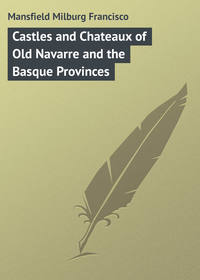 полная версия
полная версияThe Cathedrals of Southern France
As a historical monument of rank far more interest centres around the Arc de Triomphe of Germanicus, which originally formed a part of the bridge which spans the Charente at this point. It was erected in the reign of Nero by Caius Julius Rufus, a priest of Roma and Augustus, in memory of Germanicus, Tiberius, his uncle, and his father, Drusus.
The bridge itself, or what was left of it, was razed in the nineteenth century, which is of course to be regretted. A monument which could have endured a matter of eighteen hundred years might well have been left alone to takes its further chances with Father Time. Since then the bridge has been rebuilt on its former site, a procedure which makes the hiatus and the false position of the arch the more apparent. The cloister of the cathedral, in spite of the anachronism, is in the early Gothic manner, and the campanile is of the fifteenth century.
Saintes became a bishopric, in the province of Bordeaux, in the third century. St. Eutrope – whose name is perpetuated in a fine Romanesque church of the city – was the first bishop. The year 1793 saw the suppression of the diocesan seat here, in favour of Angoulême.
In the main, the edifice is of a late date, in that it was entirely rebuilt in the latter years of the sixteenth century, after having suffered practical devastation in the religious wars of that time.
The first mention of a cathedral church here is of a structure which took form in 1117 – the progenitor of the present edifice. Such considerable repairs as were necessary were undertaken in the fifteenth century, but the church seen to-day is almost entirely of the century following.
The most remarkable feature of note, in connection with this ci-devant cathedral, is unquestionably the luxurious flamboyant tower of the fifteenth century.
This really fine tower is detached from the main structure and occupies the site of the church erected by Charlemagne in fulfilment of his vow to Pepin, his father, after defeating Gaiffre, Duc d'Aquitaine.
In the interior two of the bays of the transepts – which will be readily noted – date from the twelfth century, while the nave is of the fifteenth, and the vaulting of nave and choir – hardy and strong in every detail – is, in part, as late as the mid-eighteenth century.
The Église de St. Eutrope, before mentioned, is chiefly of the twelfth century, though its crypt, reputedly the largest in all France, is of a century earlier.
Saintes is renowned to lovers of ceramics as being the birthplace of Bernard Pallisy, the inventor of the pottery glaze; and is the scene of many of his early experiments. A statue to his memory adorns the Place Bassompierre near the Arc de Triomphe.
X
CATHÉDRALE DE TULLE
The charm of Tulle's cathedral is in its imposing and dominant character, rather than in any inherent grace or beauty which it possesses.
It is not a beautiful structure; it is not even picturesquely disposed; it is grim and gaunt, and consists merely of a nave in the severe Romanesque-Transition manner, surmounted by a later and non-contemporary tower and spire.
In spite of this it looms large from every view-point in the town, and is so lively a component of the busy life which surrounds it that it is – in spite of its severity of outline – a very appealing church edifice in more senses than one.
Its tall, finely-proportioned tower and spire, which indeed is the chief attribute of grace and symmetry, is of the fourteenth century, and, though plain and primitive in its outlines, is far more pleasing than the crocketed and rococo details which in a later day were composed into something which was thought to be a spire.
In the earliest days of its history, this rather bare and cold church was a Benedictine monastery whose primitive church dated as far back as the seventh century. There are yet remains of a cloister which may have belonged to the early church of this monastic house, and as such is highly interesting, and withal pleasing.
The bishopric was founded in 1317 by Arnaud de St. Astier. The Revolution caused much devastation here in the precincts of this cathedral, which was first stripped of its trésor, and finally of its dignity, when the see was abolished.
XI
ST. PIERRE D'ANGOULÊME
Angoulême is often first called to mind by its famous or notorious Duchesse, whose fame is locally perpetuated by a not very suitable column, erected in the Promenade Beaulieu in 1815. There is certainly a wealth of romance to be conjured up from the recollection of the famous Counts of Angoulême and their adherents, who made their residence in the ancient château which to-day forms in part the Hôtel de Ville, and in part the prison. Here in this château was born Marguerite de Valois, the Marguerite of Marguerites, as François I. called her; here took welcome shelter, Marie de Medici after her husband's assassination; and here, too, much more of which history tells.
What most histories do not tell is that the cathedral of St. Pierre d'Angoulême, with the cathedral of St. Front at Périgueux and Notre Dame de Poitiers, ranks at the very head of that magnificent architectural style known as Aquitanian.
St. Ansone was the first bishop of the diocese – in the third century. The see was then, as now, a suffragan of Bordeaux. Religious wars, here as throughout Aquitaine, were responsible for a great unrest among the people, as well as the sacrilege and desecration of church property.
The most marked spoliation was at the hands of the Protestant Coligny, the effects of whose sixteenth-century ravages are yet visible in the cathedral.
A monk – Michel Grillet – was hung to a mulberry-tree, – which stood where now is the Place du Murier (mulberry), – by Coligny, who was reviled thus in the angry dying words of the monk: "You shall be thrown out of the window like Jezebel, and shall be ignominiously dragged through the streets." This prophecy did not come true, but Coligny died an inglorious death in 1572, at the instigation of the Duc de Guise.
This cathedral ranks as one of the most curious in France, and, with its alien plan and details, has ever been the object of the profound admiration of all who have studied its varied aspects.
Mainly it is a twelfth-century edifice throughout, in spite of the extensive restorations of the nineteenth century, which have eradicated many crudities that might better have been allowed to remain. It is ranked by the Ministère des Beaux Arts as a Monument Historique.
The west front, in spite of the depredations before, during, and after the Revolution, is notable for its rising tiers of round-headed arches seated firmly on proportionate though not gross columns, its statued niches, the rich bas-reliefs of the tympanum of its portal, the exquisite arabesques, of lintel, frieze, and archivolt, and, above all, its large central arch with Vesica piscis, and the added decorations of emblems of the evangels and angels. In addition to all this, which forms a gallery of artistic details in itself, the general disposition of parts is luxurious and remarkable.
As a whole, St. Pierre is commonly credited as possessing the finest Lombard detail to be found in the north; some say outside of Italy. Certainly it is prodigious in its splendour, whatever may be one's predilections for or against the expression of its art.
The church follows in general plan the same distinctive style. Its tower, too, is Lombard, likewise the rounded apside, and – though the church is of the elongated Latin or cruciform ground-plan – its possession of a great central dome (with three others above the nave – and withal aisleless) points certainly to the great domed churches of the Lombard plain for its ancestry.
The western dome is of the eleventh century, the others of the twelfth. Its primitiveness has been more or less distorted by later additions, made necessary by devastation in the sixteenth century, but it ranks to-day, with St. Front at Périgueux, as the leading example of the style known as Aquitanian.
Above the western portal is a great window, very tall and showing in its glass a "Last Judgment."
A superb tower ends off the croisillon on the north and rises to the height of one hundred and ninety-seven feet. "Next to the west front and the domed roofing of the interior, this tower ranks as the third most curious and remarkable feature of this unusual church." This tower, in spite of its appealing properties, is curiously enough not the original to which the previous descriptive lines applied; but their echo may be heard to-day with respect to the present tower, which is a reconstruction, of the same materials, and after the same manner, so far as possible, as the original.
As the most notable and peculiar details of the interior, will be remarked the cupolas of the roof, and the lantern at the crossing, which is pierced by twelve windows.
For sheer beauty, and its utile purpose as well, this great lanthorn is further noted as being most unusual in either the Romanesque or Gothic churches of France.
The choir is apse-ended and is surrounded by four chapels of no great prominence or beauty.
The south transept has a tour in embryo, which, had it been completed, would doubtless have been the twin of that which terminates the transept on the north.
The foundations of the episcopal residence, which is immediately beside the cathedral (restored in the nineteenth century), are very ancient. In its garden stands a colossal statue to Comte Jean, the father of François I.
Angoulême was the residence of the Black Prince after the battle of Poitiers, though no record remains as to where he may have lodged. A house in the Rue de Genève has been singled out in the past as being where John Calvin lived in 1533, but it is not recognizable to-day.
XII
NOTRE DAME DE MOULINS
"Les Bourbonnais sont aimables, mais vains, légers et facilement oublieux, avec rien d'excessif, rien d'exubérance dans leur nature."
– André Rolland.Until he had travelled through Bourbonnais, "the sweetest part of France – in the hey-day of the vintage," said Sterne, "I never felt the distress of plenty."
This is an appropriate enough observation to have been promulgated by a latter-day traveller. Here the abundance which apparently pours forth for every one's benefit knows no diminution one season from another. One should not allow his pen to ramble to too great an extent in this vein, or he will soon say with Sterne: "Just Heaven! it will fill up twenty volumes, – and alas, there are but a few small pages!"
It suffices, then, to reiterate, that in this plenteous land of mid-France there is, for all classes of man and beast, an abundance and excellence of the harvest of the soil which makes for a fondness to linger long within the confines of this region. Thus did the far-seeing Bourbons, who, throughout the country which yet is called of them, set up many magnificent establishments and ensconced themselves and their retainers among the comforts of this world to a far greater degree than many other ruling houses of mediæval times. Perhaps none of the great names, among the long lists of lords, dukes, and kings, whose lands afterward came to make the solidarity of the all-embracing monarchy, could be accused of curtailing the wealth of power and goods which conquest or bloodshed could secure or save for them.
The power of the Bourbons endured, like the English Tudors, but a century and a half beyond the period of its supremacy; whence, from its maturity onward, it rotted and was outrooted bodily.
The literature of Moulins, for the English reading and speaking world, appears to be an inconsiderable quantity. Certain romances have been woven about the ducal château, and yet others concerning the all-powerful Montmorencies, besides much history, which partakes generously of the components of literary expression.
In the country round about – if the traveller has come by road, or for that matter by "train omnibus" – if he will but keep his eyes open, he will have no difficulty in recognizing this picture: "A little farmhouse, surrounded with about twenty acres of vineyard, and about as much corn – and close to the house, on one side, a potagerie of an acre and a half, full of everything which could make plenty in a French peasant's house – and on the other side a little wood, which furnished wherewithal to dress it."
To continue, could one but see into that house, the picture would in no small degree differ from this: "A family consisting of an old, gray-headed man and his wife, with five or six sons and sons-in-law, and their several wives, and a joyous genealogy out of them … all sitting down together to their lentil soup; a large wheaten loaf in the middle of the table; and a flagon of wine at each end of it, and promised joy throughout the various stages of the repast."
Where in any other than this land of plenty, for the peasant and prosperous alike, could such a picture be drawn of the plenitude which surrounds the home life of a son of the soil and his nearest kin? Such an equipment of comfort and joy not only makes for a continuous and placid contentment, but for character and ambition; in spite of all that harum-scarum Jeremiahs may proclaim out of their little knowledge and less sympathy with other affairs than their own. No individualism is proclaimed, but it is intimated, and the reader may apply the observation wherever he may think it belongs.
Moulins is the capital of the Bourbonnais – the name given to the province and the people alike. The derivation of the word Bourbon is more legendary than historical, if one is to give any weight to the discovery of a tablet at Bourbonne-les-Bains, in 1830, which bore the following dedication:
DEO, APOLLINIBORVONIET DAMONAEC DAMINIUSFEROX CIVISLINGONUS EXVOTOIts later application to the land which sheltered the race is elucidated by a French writer, thus:
"Considering that the names of all the cities and towns known as des sources d'eaux thermales commence with either the prefix Bour or Bor, indicates a common origin of the word … from the name of the divinity which protects the waters."
This is so plausible and picturesque a conjecture that it would seem to be true.
Archæologists have singled out from among the most beautiful chapelles seigneuriales the one formerly contained in the ducal palace of the Bourbons at Moulins. This formed, of course, a part of that gaunt, time-worn fabric which faces the westerly end of the cathedral.
Little there is to-day to suggest this splendour, and for such one has to look to those examples yet to be seen at Chambord or Chenonceaux, or that of the Maison de Jacques Cœur at Bourges, with which, in its former state, this private chapel of the Bourbons was a contemporary.
The other chief attraction of Moulins is the theatrical Mausolée de Henri de Montmorency, a seventeenth-century work which is certainly gorgeous and splendid in its magnificence, if not in its æsthetic value as an art treasure.
The fresh, modern-looking cathedral of Notre Dame de Moulins is a more ancient work than it really looks, though in its completed form it dates only from the late nineteenth century, when the indefatigable Viollet-le-Duc erected the fine twin towers and completed the western front.
The whole effect of this fresh-looking edifice is of a certain elegance, though in reality of no great luxuriousness.
The portal is deep but unornamented, and the rose window above is of generous design, though not actually so great in size as at first appears. Taken tout ensemble this west front – of modern design and workmanship – is far more expressive of the excellent and true proportions of the mediæval workers than is usually the case.
The spires are lofty (312 feet) and are decidedly the most beautiful feature of the entire design.
The choir, the more ancient portion (1465-1507), expands into a more ample width than the nave and has a curiously squared-off termination which would hardly be described as an apside, though the effect is circular when viewed from within. The choir, too, rises to a greater height than the nave, and, though there is no very great discrepancy in style between the easterly and westerly ends, the line of demarcation is readily placed. The square flanking chapels of the choir serve to give an ampleness to the ambulatory which is unusual, and in the exterior present again a most interesting arrangement and effect.
The cathedral gives on the west on the Place du Château, with the bare, broken wall of the ducal château immediately en face, and the Gendarmerie, which occupies a most interestingly picturesque Renaissance building, is immediately to the right.
The interior arrangements of this brilliant cathedral church are quite as pleasing and true as the exterior. There is no poverty in design or decoration, and no overdeveloped luxuriance, except for the accidence of the Renaissance tendencies of its time.
There is no flagrant offence committed, however, and the ambulatory of the choir and its queer overhanging gallery at the rear of the altar are the only unusual features from the conventional decorated Gothic plan; if we except the baldachino which covers the altar-table, and which is actually hideous in its enormity.
The bishop's throne, curiously enough, – though the custom is, it appears, very, very old, – is placed behind the high-altar.
The triforium and clerestory of the choir have gracefully heightened arches supported by graceful pillars, which give an effect of exceeding lightness.
In the nave the triforium is omitted, and the clerestory only overtops the pillars of nave and aisles.
The transepts are not of great proportions, but are not in any way attenuated.
Under the high-altar is a "Holy Sepulchre" of the sixteenth century, which is penetrated by an opening which gives on the ambulatory of the choir.
There is a bountiful display of coloured glass of the Renaissance period, and, in the sacristy, a triptych attributed to Ghirlandajo.
There are no other artistic accessories of note, and the cathedral depends, in the main, for its satisfying qualities in its general completeness and consistency.
XIII
NOTRE DAME DE LE PUY
"Under the sun of the Midi I have seen the Pyrenees and the Alps, crowned in rose and silver, but I best love Auvergne and its bed of gorse."
– Pierre de Nolhac.Le Puy has been called – by a discerning traveller – and rightly enough, too, in the opinion of most persons – "the most picturesque spot in the world." Whether every visitor thereto will endorse this unqualifiedly depends somewhat on his view-point, and still more on his ability to discriminate.
Le Puy certainly possesses an unparalleled array of what may as well be called rare attractions. These are primarily the topographical, architectural, and, first, last, and all times, picturesque elements which only a blind man could fail to diagnose as something unique and not to be seen elsewhere.
In the first category are the extraordinary pinnacles of volcanic rock with which the whole surrounding landscape is peopled; in the second, the city's grand architectural monuments, cathedrals, churches, monastery and the château of Polignac; while thirdly, the whole aspect is irritatingly picturesque to the lover of topographical charm and feature. Here the situation of the city itself, in a basin of surrounding peaks, its sky-piercing, turreted rocks, and the general effect produced by its architectural features all combine to present emotions which a large catalogue were necessary to define.
Moreover, Le Puy is the gateway to a hitherto almost unknown region to the English-speaking tourist. At least it would have been unknown but for the eulogy given it by the wandering Robert Louis Stevenson, who, in his "Travels with a Donkey," (not "On a Donkey," – mark the distinction), has made the Cevennes known, at least as a nodding acquaintance, to – well, a great many who would never have consciously realized that there was such a place.
Le Puy is furthermore as yet unspoiled by the "conducted tourist," and lives the same life that it has for many generations. Electric trams have come to be sure, and certain improvements in the way of boulevards and squares have been laid out, but, in the main, the narrow, tortuous streets which ascend to its cathedral-crowned height are much as they always were; and the native pays little heed to the visitor, of which class not many ever come to the city – perhaps for the reason that Le Puy is not so very accessible by rail. Both by the line which descends the Rhône valley and its parallel line from Paris to Nîmes, one has to branch off, and is bound to lose from three to six hours – or more, at some point or other, making connections. This is as it should be – in spite of the apparent retrogression.
When one really does get to Le Puy nothing should satisfy him but to follow the trail of Stevenson's donkey into the heart of the Cevennes, that wonderful country which lies to the southward, and see and know for himself some of the things which that delectable author set forth in the record of his travels.
Monastier, Le Cheylard, La Bastide, Notre Dame des Neiges, Mont Mézenac, and many more delightful places are, so far as personal knowledge goes, a sealed book to most folk; and after one has visited them for himself, he may rest assured they will still remain a sealed book to the mass.
The ecclesiastical treasures of Le Puy are first and foremost centred around its wonderful, though bizarre, Romanesque cathedral of Notre Dame.
Some have said that this cathedral church dates from the fifth century. Possibly this is so, but assuredly there is no authority which makes a statement which is at all convincing concerning any work earlier than the tenth century.
Le Puy's first bishop was St. Georges, – in the third century, – at which time, as now, the diocese was a suffragan of Bourges.
The cathedral itself is perched on a hilltop behind which rises an astonishing crag or pinnacle, – the rocher Corneille, which, in turn, is surmounted by a modern colossal bronze figure, commonly called Notre Dame de France. The native will tell you that it is called "the Virgin of Le Puy." Due allowance for local pride doubtless accounts for this. Its height is fifty feet, and while astonishingly impressive in many ways, is, as a work of art, without beauty in itself.
There is a sort of subterranean or crypt-like structure, beneath the westerly end of the cathedral, caused by the extreme slope of the rock upon which the choir end is placed. One enters by a stairway of sixty steps, which is beneath the parti-coloured façade of the twelfth century. It is very striking and must be a unique approach to a cathedral; the entrance here being two stories below that of the pavement of nave and choir. This porch of three round-arched naves is wholly unusual. Entrance to the main body of the church is finally gained through the transept.
The whole structure is curiously kaleidoscopic, with blackish and dark brown tints predominating, but alternating – in the west façade, which has been restored in recent times – with bands of a lighter and again a darker stone. It has been called by a certain red-robed mentor of travel-lore an ungainly, venerable, but singular edifice: quite a non-committal estimate, and one which, like most of its fellows, is worse than a slander. It is most usually conceded by French authorities —who might naturally be supposed to know their subject– that it is very nearly the most genuinely interesting exposition of a local manner of church-building extant; and as such the cathedral at Le Puy merits great consideration.
The choir is the oldest portion, and is probably not of later date than the tenth century. The glass therein is modern. It has a possession, a "miraculous virgin," – whose predecessor was destroyed in the fury of the Revolution, – which is supposed to work wonders upon those who bestow an appropriate votive offering. To the former shrine came many pilgrims, numbering among them, it is said rather indefinitely and doubtfully, "several popes and the following kings: Louis VII., Philippe-Auguste, Philippe-le-Hardi, Charles VI., Charles VII., Louis XI., and Charles VIII."











